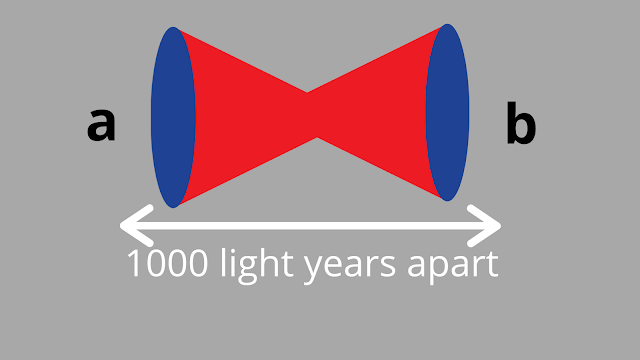one of the theoretically possible ways of traveling in time or into another world is by using wormholes
________________________________________________________
wormhole meaning
a wormhole also is known as the einstein-Rosen bridge is a shortcut through space and timewhat we mean by a shortcut is that distance between two very distant points in space can be reduced with their use
this idea might seem to be impossible at first because our general perception of space tells us that space is unaffectable
to understand this concept, space can be thought o behave like a stretched rubber membrane
space can be bent, stretched, or contracted
to analogically understand wormhole, consider 2 dots on a piece of paper
the shortest path to reach from one dot to other is along the straight line passing through them
but if we bent this paper and place one dot over the other, we reduce the distance to reach from one point to other
this is how a wormhole works, in a sheet of space
________________________________________________________
do wormholes exist
wormholes can exist theoretically but, there is experimental evidence if their existence
there are a set of equations in physics which mathematically allow wormholes to exist
moreover, there have been a number of incidences of time travel and encounter with another worldly people, which are explainable only with the help of wormholes
________________________________________________________
how are wormholes created
wormholes are created naturally by quantum fluctuations in spacespace can be thought of as a stretched rubber membrane, whenever anything is present in it space is curved around it
according to einstein's mass-energy equivalence mass can be converted into energy
for converting mass completely into energy, we need to make it in contact with antimatter, and after interaction both matter and antimatter annihilate each other, giving a blow of energy
the opposite of this process is continuously taking place in space, matter and antimatter pop out of nowhere and annihilate each other
this creates vibrations in space just as a stretched membrane can vibrate when disturbed
these vibrations give rise to wormholes, but they are microscopic in size and are closed within seconds
________________________________________________________
traveling through wormholes
for wormhole travel, we need to use exotic matter, to prevent gravity from closing it
we primarily face 2 problems in wormhole travel-
- they are microscopic in size
- they are extremely unstable
both of these can be solved with the use of exotic matter or a matter with negative mass
the exotic matter has negative energy density so it will oppose gravity from closing the wormhole
exotic matter is largely theoretical and practically isn't observed, but scientists have created something close to exotic matter in labs, and these attempts light our hopes to time travel
________________________________________________________
blackholes and wormholes
here are 8 basic differences between a wormhole and a black hole
________________________________________________________
| WORMHOLES | BLACKHOLES |
|---|---|
| #1 wormhole is a shortcut through space and time | #1 a black hole is a rip through the space-time fabric |
| #2 when you jump into a wormhole you reach another point in space | #2 journey through a black hole would, most probably, never end as it takes infinite time to cross a black hole |
| #3 a wormhole is like a tunnel | #3 a black hole is like a never-ending hole |
| #4 wormholes don't have an event horizon | #4 a black hole has an event horizon |
| #5 a wormhole may connect 2 entangled black holes | #5 2 black holes may be present at the ends of a wormhole tunnel |
| #6 wormholes are formed by quantum fluctuations in space | #6 black holes are formed by the collapse of a dying star |
| #7 wormholes are extremely unstable | #7 black holes are stable |
| #8 wormholes may close within a fraction of seconds after they are formed | #8 a supermassive black hole may take up to 10^100 years to evaporate |



Comments
Post a Comment